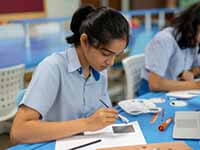The best explanations of what is international curriculum or international education can be found at Wikipedia or International Baccalaureate Organisation (IBO). Wikipedia says International education refers to a dynamic concept that involves a journey or movement of people, minds, or ideas across political and cultural frontiers and IBO explains it as “Developing citizens of the world in relation to culture, language and learning to live together.
However, if you really want to delve deeper into the various aspects of international education and feel curious to know what actually it feels like to be a part of an institution that imparts international curriculum, then a visit to GIIS SMART Campus can take you a step ahead in your quest.
At the first glance, you might miss noticing the diversity that the school has, because the campus is magnificent and spread-out and its difficult to notice all the students and staff at one go. However, diversity is not the biggest parameter that defines international education and there are many other factors that make education truly international.
What makes GIIS a truly international school?
Internationally recognised courses for students
A school in the domain of international education would offer curricula and courses that are internationally recognised and those that are geared towards offering a global outlook to students. The international curricula will aim at developing a wider perspective among students and teach them to smoothly transition amidst diversity.
Here at GIIS SMART Campus, international education consists of globally recognised programmes. This journey begins with the International Baccalaureate Primary years programme (PYP) and ends with the IB Diploma Programmefor further tertiary education. Compared to many international schools in Singapore, GIIS is one of the few schools that offers Cambridge (CLSP), offering students a great head start to international education up to IB Diploma Programme in high school.
These purposely chosen curricula at GIIS ensure that each child develops the specific understanding, skills and techniques that provide a clear path for future assessments and, therefore, academic success.
Unique approach to learning and teaching
The IBO states that” Stimulating curiosity and inquiry in order to foster a spirit of discovery and enjoyment of learning” is vital as the first step in international education. GIIS uses age-appropriate pedagogical approaches to frame inquiry-based lessons.
When I visited PYP year 5 grades Unit of Inquiry mini-exhibition on the human body, it was fantastic to see how engaged the learners were and how enthusiastic and proud they were to explain about their work. The methods of teaching applied by the teacher were based on developing research skills, evaluating information, and using notably the ‘SOLO taxonomy’ hexagon process, where students move their thinking from simple connections to exploring more abstract and complex ones by collaboration. This deep learning tool is also commonly used with IBDP students, and I was struck by how similar these approaches are! The primary students were using the same visible learning techniques to make connections between ideas and concepts with focus on research and communication.
The best practices for engaging curiosity and sharing of ideas to build knowledge are inherent and explicit at all ages in a classroom thats delivering international curriculum.
Similarly, IBO believes that a truly international education allows students to “build and reinforce their own sense of identity and cultural awareness”. Recently I was fortunate to visit a year 6 CLSP revision class for Global Perspectives where the students were learning about Reasons for the migration of people. The students shared their ideas with the teacher who simultaneously them on an iPad and instantly projected students ideas on a big screen. To help solidify their understanding, I volunteered to be an example of someone who migrated to Singapore ten years ago. The students then asked impressively insightful questions on why I left my home country and probed into my Singapore experiences. They demonstrated they could apply this ‘real-life situation’ and international context to the push and pull factors of migration at a conceptually challenging level.
The teachers approach exemplifies how teaching at GIIS enables the students to look further than their own culture and society and critically evaluate different perspectives.
Strategic approach towards holistic development
A well-rounded personality is the main trait of an individual who has studied under an international curriculum. At GIIS, Even though academic excellence is a top priority, it is not at the expense of holistic or wholesome character development. Students of all ages are exposed to the different attributes through the 9 GEMS framework that aims at a comprehensive development of students, including universal values that are integral to IBO’s international education definition.
GIIS does indeed live up to high standards of international education and offers a comprehensive approach with the focus on preparing students to be active and engaged participants in an interconnected world.
For more information, click here.

































